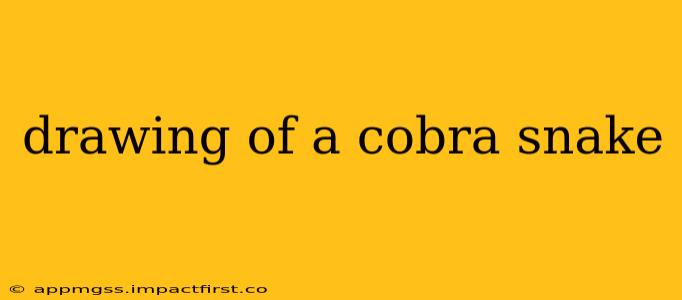Drawing a cobra, with its iconic hood and captivating gaze, can be a rewarding challenge for artists of all skill levels. This guide will walk you through the process, offering tips and techniques to help you create a realistic and expressive portrayal of this magnificent creature. Whether you're a seasoned artist or just starting out, you'll find valuable insights here.
Understanding Cobra Anatomy: The Foundation of Your Drawing
Before you pick up your pencil, it's crucial to understand the cobra's anatomy. Observe reference images – photographs are ideal – focusing on the proportions of the body, the shape of the head, and the distinctive hood. Note the subtle curves of the spine, the placement of the eyes, and the details of the scales. Understanding these aspects will significantly impact the realism of your final drawing.
What are the key features of a cobra's anatomy I should focus on?
The most important features to capture are the cobra's elongated body, its relatively small head compared to the body, and, of course, the distinctive hood. Pay close attention to the way the muscles flex and extend the hood, creating a dramatic and often intimidating posture. The scales themselves are another crucial element; they give the cobra's skin a textured appearance. Finally, the eyes – often described as piercing and intelligent – are a crucial element in conveying the cobra’s personality.
Step-by-Step Guide to Drawing a Cobra
Let's move on to the actual drawing process. We'll break it down into manageable steps:
-
Sketching the Basic Shapes: Start with simple shapes – circles and ellipses – to establish the basic proportions of the head and body. Use light pencil strokes to allow for easy adjustments.
-
Refining the Head and Hood: Gradually refine the head, paying close attention to the shape of the snout, the placement of the eyes and nostrils, and the contours of the hood. Consider the cobra's posture – is it coiled, ready to strike, or relaxed?
-
Adding the Body and Tail: Extend the body from the head, maintaining the smooth, slightly sinuous curves characteristic of a cobra. The tail should taper gracefully to a point. Remember to consider the position of the belly scales which run down the underside.
-
Detailing the Scales and Texture: Add the scales, carefully observing the pattern and overlapping nature of each scale. Use hatching or cross-hatching to create a sense of texture and depth, adding shadows to define the folds in the skin.
-
Adding the Eyes and Other Details: Carefully render the eyes, capturing their intensity and glint. Add any other details, such as forked tongues or subtle markings on the scales, to enhance realism.
-
Shading and Value: Use shading to give your drawing three-dimensionality. Observe how light falls on the cobra's body and adjust your shading accordingly. Consider using a range of tones to create depth and contrast.
-
Final Touches: Once you're happy with your drawing, you can add final details such as background elements or adjust the lines to further refine your work.
What materials do I need to draw a cobra?
You can use a variety of materials. Pencils (H2-6B range) are a great starting point, allowing you to easily erase and adjust your work. You can also use charcoal for bolder lines and richer darks, or even colored pencils to capture the subtle colors and patterns of the snake's skin.
How can I make my cobra drawing look more realistic?
Achieving realism comes from keen observation and attention to detail. Use good quality reference photos, pay close attention to the anatomy, and don't be afraid to experiment with shading and texture to create a three-dimensional effect. Practice is also key!
Are there any specific drawing techniques I should use for drawing a cobra's scales?
Yes, several techniques can help render cobra scales realistically. Hatching and cross-hatching create texture, while using a lighter pencil for the highlights and a darker one for the shadows will enhance the three-dimensionality. You could even use a stippling technique to simulate the scales' small, overlapping nature. Experiment with different approaches to find what works best for you.
By following these steps and practicing regularly, you will improve your ability to draw a cobra with skill and confidence. Remember to always be respectful of these magnificent creatures and appreciate their beauty in your artwork.
